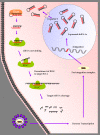Selective gene silencing by viral delivery of short hairpin RNA
- PMID: 20858246
- PMCID: PMC2949849
- DOI: 10.1186/1743-422X-7-248
Selective gene silencing by viral delivery of short hairpin RNA
Abstract
RNA interference (RNAi) technology has not only become a powerful tool for functional genomics, but also allows rapid drug target discovery and in vitro validation of these targets in cell culture. Furthermore, RNAi represents a promising novel therapeutic option for treating human diseases, in particular cancer. Selective gene silencing by RNAi can be achieved essentially by two nucleic acid based methods: i) cytoplasmic delivery of short double-stranded (ds) interfering RNA oligonucleotides (siRNA), where the gene silencing effect is only transient in nature, and possibly not suitable for all applications; or ii) nuclear delivery of gene expression cassettes that express short hairpin RNA (shRNA), which are processed like endogenous interfering RNA and lead to stable gene down-regulation. Both processes involve the use of nucleic acid based drugs, which are highly charged and do not cross cell membranes by free diffusion. Therefore, in vivo delivery of RNAi therapeutics must use technology that enables the RNAi therapeutic to traverse biological membrane barriers in vivo. Viruses and the vectors derived from them carry out precisely this task and have become a major delivery system for shRNA. Here, we summarize and compare different currently used viral delivery systems, give examples of in vivo applications, and indicate trends for new developments, such as replicating viruses for shRNA delivery to cancer cells.
Figures

References
Publication types
MeSH terms
Substances
LinkOut - more resources
Full Text Sources
Other Literature Sources

